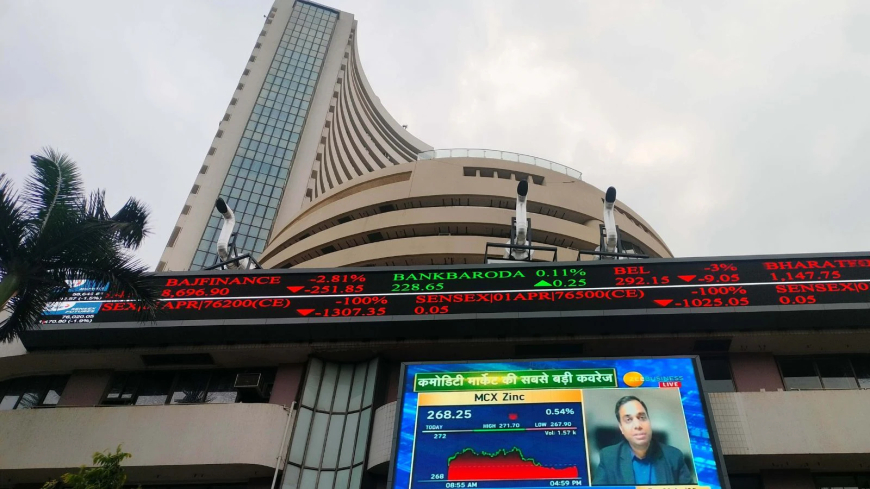Nifty50, Sensex Stay Resilient as India–US Trade Talks Enter Decisive Phase
Indian stock markets remain steady as high-stakes India–US trade talks loom. Explore how tariff outcomes, export policies, and investor sentiment could shape Nifty and Sensex performance in the near term.

Nifty50 and Sensex Remain Flat as India–US Trade Talks Enter Make-or-Break Stage
As of Thursday’s market close, India’s key stock indices—Nifty50 and the BSE Sensex—held steady, reflecting a wait-and-watch approach by investors ahead of the crucial India–US trade discussions expected to commence next week in Washington, D.C. While the indices displayed minimal volatility, the underlying current in Dalal Street was anything but calm.
At a time when global markets are watching for cues on geopolitical trade alignments, the outcome of these bilateral talks could have far-reaching consequences for Indian exports, import tariffs, and market confidence.
Market Snapshot: Muted Volatility, Heightened Anxiety
The Nifty50 closed at 23,395, up a marginal 0.18%, while the Sensex ended the day at 77,112, up 0.15%. Market participants largely refrained from large trades, reflecting caution as policy uncertainty looms.
Sectoral Indices Mixed:
-
Auto, Pharma, and IT stocks saw minor upticks, as they stand to benefit from relaxed export barriers.
-
Metals and FMCG sectors were down, reacting to fears of possible tariffs or protectionist moves from the U.S.
Meanwhile, the India VIX, a key indicator of market volatility, remained elevated at 13.84, indicating trader uncertainty.
See full market summary on NSE India
India–US Trade Dialogue: What's at Stake?
This round of India–US trade talks could become a defining moment for both nations' economic alignment. After years of friction around tariffs, agriculture, and digital trade, the current political climate—marked by U.S. elections approaching in 2025 and India’s increased export ambitions—offers a window of opportunity for resolution.
Key Agendas Include:
-
Tariff Rollbacks: India seeks to remove punitive tariffs imposed on steel and aluminum in previous administrations. In return, the U.S. is expected to push for greater market access in India’s agri and tech sectors.
-
Pharmaceutical and Medical Exports: With India being a key supplier of generics, there are demands for expedited approvals and fewer regulatory barriers in the U.S. market.
-
Digital Trade and Data Sovereignty: The U.S. wants relaxed rules on data localization, while India is pushing back citing national security.
-
Textiles and Apparel Access: Indian exporters hope for duty-free access to the U.S. apparel market to offset Chinese dominance.
“A favorable outcome could push India’s goods exports to the U.S. beyond $100 billion annually,” says Rajiv Kumar, former Vice Chair of NITI Aayog.
Read the full USTR India Trade Policy Review
Investor Sentiment: On Guard, Not Gloomy
Despite a flat market, institutional investors remain cautiously optimistic. According to data from the NSDL, foreign portfolio investors (FPIs) bought equities worth ₹1,285 crore this week—indicating steady confidence in India's macro story.
Key Factors Supporting Market Stability:
-
RBI’s dovish stance in recent policy reviews keeps liquidity flowing.
-
Healthy corporate earnings from Q1 FY26 have reaffirmed domestic consumption strength.
-
Strong GST and PMI numbers suggest continued industrial resilience.
But it’s the outcome of the India–US trade talks that could provide either a boost or a break to investor confidence.
"A successful agreement could result in rerating export-heavy stocks like Tata Motors, Dr. Reddy’s, Infosys, and Welspun India," says Sandeep Mehta, equity strategist at JM Financial.
See recent FPI investment trends at NSDL
Exporters on Edge: Sectors Poised for Action
The real pulse of the trade talks will be felt by India's export-intensive industries. Several companies are already positioned for upside—if the trade corridor to the U.S. is widened.
1. Information Technology (IT):
With U.S. accounting for over 60% of Indian IT exports, the sector is hoping for improved visa policies and fewer restrictions on cross-border data flow.
-
Likely gainers: Infosys, HCL Tech, TCS
2. Pharmaceuticals:
Indian pharma firms, especially generics and biosimilars producers, could gain from expedited U.S. FDA approvals and import relaxations.
-
Likely gainers: Sun Pharma, Cipla, Lupin
3. Textiles & Apparel:
With a focus on decoupling from China, Indian garment exporters want zero-duty access under Generalized System of Preferences (GSP)-like programs.
-
Likely gainers: Welspun India, Arvind Ltd, Raymond
4. Auto Components:
The U.S. has shown interest in India as a resilient alternative to Chinese supply chains. Local firms could get an export push.
-
Likely gainers: Motherson Sumi, Bharat Forge
Political Optics: Trade as Diplomacy
The trade talks are not just about economics—they're also highly symbolic. Prime Minister Narendra Modi’s administration has pitched India as a global manufacturing and tech alternative, while the Biden administration seeks to diversify supply chains beyond China.
The upcoming strategic dialogue between Indian and U.S. trade ministers also sets the stage for broader quad cooperation, including energy, climate, and cybersecurity.
“This is trade diplomacy in motion. The tone of this round could define India’s trade posture for the next five years,” notes Sujata Mehta, former Indian ambassador to the WTO.
Risks: What Could Go Wrong?
Despite optimism, risks persist:
-
Protectionist pressures in the U.S., particularly ahead of elections, could stall tariff rollbacks.
-
Unresolved digital trade frictions, especially concerning India’s new Digital Personal Data Protection Act, may act as a deal-breaker.
-
Domestic opposition parties in India have raised concerns about compromising on agriculture and data privacy.
Any deadlock or misstep could not only weigh on equities but also affect rupee valuation and FDI inflows.
Conclusion: An Inflection Point for Policy and Portfolio
The flat movement in Nifty50 and Sensex belies the importance of the upcoming India–US trade discussions. While investors maintain composure, the markets are silently building up to what could be a defining moment in India’s trade and investment trajectory.
If resolved positively, the talks could unlock a new export era for India, enhance strategic cooperation, and offer fresh momentum to equities. On the flip side, failure to align on key issues might trigger short-term volatility across sectors sensitive to global trade.



















































